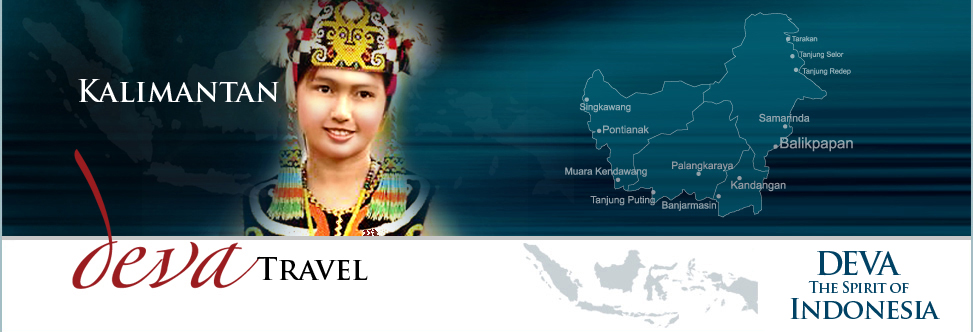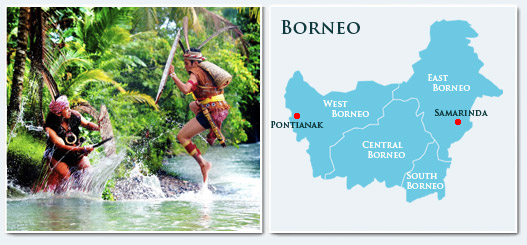Kalimantan

Day 1 Pontianak
After arrival at Pontianak there is a transfer to the hotel. By a wooden boat the riverbank area of Pontianak is explored, giving a view on the old and the new Pontianak from a different perspective. Among the highlights of the sightseeing trip are Pontianak harbour, Beting Permai water village, and the huge Kapuas Bridge.
Pontianak |
Day 2 Pontianak - Kapuas River
Departure to Putussibau in the early morning. The adventure expedition starts from here. You go towards the waters of the Kapuas by long boat. During this boat ride several Dayak villages at the river side are passed. Be amazed by their unique daily life and the several birds such as the eagle, king fisher, long tailed Parakeet and many more.
Day 3 Kapuas River - Bungan River
After breakfast, the journey continues by long boats as far as upstream. On the way a stop is made at the Dayak village to see the long house. Moreover, the boat passes some rapids, slash and burn agriculture (shifting cultivation) as well as the local people looking for gold, some by traditional way and some by machine along the river side.
De Dayak |
Day 4 Bungan River - Tanjung Lokang
Today you will see the tropical rain forest of Kalimantan, shifting cultivation, traditional gold mining in the river and temporary huts till Tanjung Lokang is reached. Tanjung Lokang is a small village located inside Betung Kerihun National Park. Here you may find various handmade crafts like "Mandau" traditional machete, "Sumpit" blow gun and "Tangguy" traditional farmer hat.
Day 5 Tanjung Lokang - Bobo/Sei Bulit
After breakfast the trekking starts across Ladang along fellow dry rice field through the forest. The first two hours are up hill and about another two and a half hours passing the jungle and a dry small river. After lunch the trek continues with ups and downs, crossing the Nyinyit Cave.
Day 6 Sei Bulit - Bungan River
After breakfast, crossing the river, up and down passing the jungle, admiring the exotic flora and fauna of Borneo. A visit is brought to temporary huts that the local people use while they do shifting cultivation or hunting deer, wild pig, birds, and even sometimes clouded leopard.
Day 7 Bungan River - Bungan Lea River
This day is a challenging trek, varied but very intensive. After breakfast you cross a big river about a half till one meter deep. Followed by walks aside the cliff and steep rocks.
Day 8 Bungan Lea River - Piang Lo'ong
This is the longest and the toughest trek. After breakfast, crossing up and down the rivers, cliff of the rivers and the river side. An adventurous spirit and energy is essential to make this trek. The campsite is set up close to the river for dinner and overnight.
Day 9 Piang Lo’ong - Muller Range
Today the border of West and East Borneo is reached. After breakfast, the journey continues with a two hour walk up and down river till the foot of Muller Range is reached. The border of West and East Kalimantan lies at 1000m above sea level. The path gets more difficult when passing the jungle. It takes about one – one and a half hours depending on your ability. No need to rush as the jungle’s view is fantastic. After reaching the "Tugu Perabatasan" (border monument), an offering is made to the spirit of the border. From this point on, the trek gets easier as it is downhill. Finally the campsite at Muller Range is reached where the evening can be spend in complete harmony.
Day 10 Muller Range - Muara Cuting
After breakfast the Dayak will show you how to survive in the jungle, collecting the rotan, hunting, catching the fish and how to set a trap. Get involved in their daily life, experience the simple standards. Overnight is at Muara Cuting.
Day 11 Muara Cuting - Saite
This is the shortest trek, for about three hours to reach Saite. The rest of the day is for leisure. There is time to relax, swim and to take a break.
Day 12 Muara Saite - Tiong Ohang
After breakfast the journey continues to the mouth of the Mahakam River, a three hour walk. On the way slash and burn agriculture is passed, before reaching the river side. Upon arrival, the long boat or locally called ‘Cest’ takes you to Tiong Ohang village for a six - seven hours journey. Dinner is at a local simple restaurant, as well as overnight. This is the first village you encounter after long days in the jungles. You may also find more crafts from Kalimantan with the best quality.
Day 13 Tiong Ohang - Long Bagun
After breakfast at the local restaurant, the journey continues by long boat for eight - ten hours. During this expedition the boat passes some big rapids. The views along the rivers are fantastic and you can walk around to see the long house and their unique daily life.
Day 14 Long Bagun
The trekking carries on, on the Mahakam River which has a unique characteristic, the tide of the river. In the dry season the level of the water could be so shallow that sometimes you have to leave Long Bagun earlier otherwise it is not possible to get the house boat when the level of the water is not reliable.
Day 15 Long Bagun
The boat will start normally at 10.00 am but could be change without prior notice to the day before. The house boat is a public traditional wooden boat with two decks; the first deck is to carry goods and economy class passengers. The second deck is for executive passengers. The rooms are very simple and standard, open on both sides. The boat will stop for picking up passengers and loading goods. During this sailing trip you will explore and learn the local way of life of the "river side civilization" which is much different from what we know.
Day 16 Samarinda
Upon arrival transfer there is a transfer to the hotel in Samarinda. The rest of the day is at leisure.
The port city of Samarinda was founded at the beginning of the eighteenth century by Buginese traders who emigrated from Sulawesi. The name Samarinda originates from the description of the way in which the Buginese houses were constructed. At that time houses were customarily built on a raft and generally had the same height. This provided important social symbolism of equality between residents; no person's house, and thus no person, was seen as higher as or lower than another. They named the settlement 'Samarenda', meaning 'equal in height'. After hundreds of years of use the pronunciation of the name changed slightly and the city became known as Samarinda. |
Day 17 Samarinda
The morning starts with a breakfast at the hotel. Afterwards there is a transfer to your next destination. The end of an amazing journey.

Price starting from € 2.765,- p.p.
* The arrangement as described can be booked as a private or as a group journey.
* Due to weather conditions the program can be changed
* The journey includes hotel or cottage accommodation with breakfast
* Transfer by private car
* Additional options can be arranged, such as:
- International or Domestic flights |



